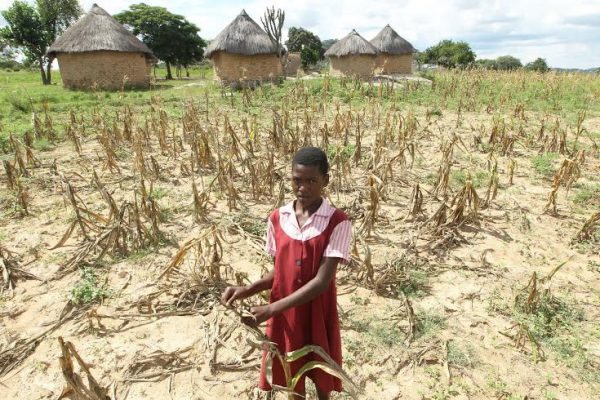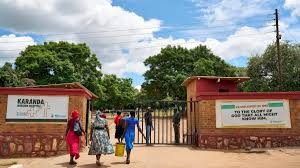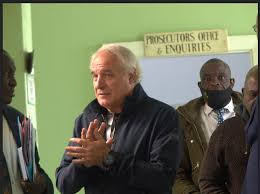
BY OBI ANYAKIDE
Loveness January lost her three cattle and half her crop to last year’s drought, and fears another poor season will mean ruin for her family farming activities at a small plot of land in Seke, 40km southeast of Harare.
“If the rains don’t come we will suffer,” she said simply. “There is nothing more we can do — we need help.”
Drought and an economic meltdown have combined to push Zimbabwe to the brink of humanitarian catastrophe, aid workers warn, with levels of hunger rarely seen outside of war zones.
By early next year, some eight million people — half the population — will be short of food.
A series of interviews and visits to urban and rural parts of Zimbabwe this month by The New Humanitarian confirmed the grim mood of official reports and warnings from aid agencies and local media.
In the countryside, after a season of poor rains, 5.5 million farmers — some of whom suffered total crop failure — will struggle to find food. In urban areas, where an inflation rate of 300% is forcing the poorest to survive on just one meal a day, 2.2 million people are affected.
“The numbers in need could easily climb well beyond six million in the rural areas by next year, and we could also see an increase in the urban areas,” World Food Programme country director, Eddie Rowe, told TNH.
- Chamisa under fire over US$120K donation
- Mavhunga puts DeMbare into Chibuku quarterfinals
- Pension funds bet on Cabora Bassa oilfields
- Councils defy govt fire tender directive
Keep Reading
The crisis is exacerbated by a formal employment rate of just 10%, an indebted government that is struggling to provide basic services, perennial shortages of fuel and foreign exchange, and regular 18-hour power cuts.
“If the government doesn’t act now, Zimbabwe is marching towards unprecedented food insecurity levels,” warned Rowe.
The 2018/19 rainy season was the driest in 40 years. The maize harvest was more than 50% down on 2018, and large-scale livestock losses mean households, like January’s in Seke, are deprived of key assets.
WFP estimates that 4.1 million people will be in urgent need of food aid by January. That includes 1.2 million mainly in northern districts bordering Zambia and Mozambique who have a food security classification of IPC 4 — emergency levels more often associated with conflict.
Consecutive droughts have sapped people’s ability to bounce back. In 2015, poor rains left 30% of rural people food insecure; in 2016 the number hit 42%; in 2018 it rose to 51% ; and this year it has reached 59% — a sign of the growing impact of climate change.
Then there was the shock of Cyclone Idai, which tore through eastern Zimbabwe in March, directly affecting 270 000 people.
Next season is expected to be dry again, with forecasts predicting below average rainfall through to March.
“Donors and humanitarian partners should prepare for atypically high food assistance needs throughout 2020,” the USAID-funded food security watchdog Fewsnet said in its latest bulletin.
WFP had originally planned to reach 2.7 million people from January to April 2020. That was predicated on a government commitment that it would feed an additional three million people.
But doubts over the government’s ability to meet that pledge have led WFP to expand its intervention to 4.1 million people, aid workers told TNH.
Scaling up so rapidly will be a challenge, Rowe acknowledged. “Reaching 4.1 million by the end of January is going to be tough,” he said. “We’ve bought in additional staff to help us get to that target.”
There is also a logistical problem. Zimbabwe’s banning of US dollar transactions and soaring inflation means that cash as aid is no longer viable. So, assistance must take the form of traditional in-kind aid — sacks of maize and bottles of cooking oil.
But after the drought there is little spare maize in the region. Zambia, the usual go-to country for food aid, has banned exports. Shipments from Mexico, another regular supplier, are months away in terms of transport time.
A further complication is that Zimbabwe will not accept genetically-modified maize. An alternative under consideration is GM maize from South Africa that has been milled and cannot propagate.
Zimbabwe is negotiating the purchase of 17 000 tonnes of maize from Tanzania, with the transport of the first tranche of 7 000 tonnes underway. But “questions around the government’s ability to import sufficient grains to fill the gap” remain, the WFP noted in a recent briefing.
A pilot urban social safety net programme funded by the UK government is an exception to in-kind aid, using mobile money transfers. It aims to reach 100,000 people “at-risk” and could be extended to 200 000 if more financing is found.
Epworth, a once informal settlement 12km from Harare, is one of eight communities where the programme is being rolled out. Poverty levels there are among the worst in the country, with roughly half the population “cereal insecure” — meaning they can’t afford even plain maize. Some 4 000 households will receive the equivalent of $9 per family member a month, via a mobile money platform.
But even here, there are hurdles. One problem is the high transaction fees charged by retailers to convert the digital cash. The premium is at least 25%, and to purchase some demand-heavy commodities like maize meal, it can be as high as 40%.
Yet the small payments make a difference. Naume Tawawa’s husband works as a market porter in central Harare, and the family could hardly afford to feed their five children and keep the three youngest in primary school. The $64 she gets “helps substantially”. She can now afford more and better food, and sanitary products for her older daughters.
But “Epworth is no longer an isolated slice of poverty,” said Amnesty International country director, Jessica Pwiti. “There are Epworths all over Zimbabwe.” — The New Humanitarian










